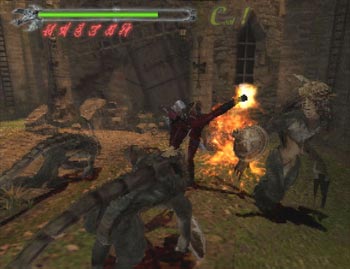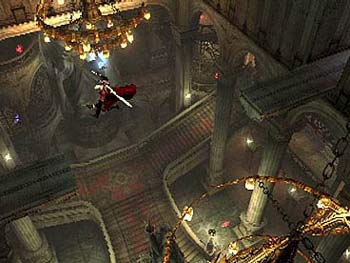The fact that there is this much good in the game is nothing short of a miracle. That this was once Resident Evil 4 is clearly evident in many parts of Devil May Cry. As much as I like Shinji Mikami games, the pre-Resident Evil 4 formula is not very conducive to an action game, and the effort is hurt by it.
 |
|
Understanding one thing separates heroes from the rest of us: Demons, murderers and the undead can all be dispatched by really high kicks.
|
The biggest problem is the camera system. It’s exactly like the one found in Code Veronica; full 3d environments with fixed camera angles that move, zoom and pan on their own. You can figure out where the changes will occur, but that’s the only control you have over it. Some of the camera angles are just bad; how is looking at Dante’s front going to help us see enemies? The bad angles are commonplace, but not problematic enough to ruin things. For me, the larger issue is how they constantly change. You could be in the middle of an intense battle, only to move a few feet in the wrong direction and find the camera is now zoomed out so far that you can’t see your target, or it shifts to look in the completely opposite direction so your controls are reversed.
I can’t say these issues caused me great amounts of trouble, but it is one of those things that you can tell is going to affect some players, and understandably drive them nuts. Try to find a good spot and make them come to you.
DMC’s Resident Evil roots also mean that the combat doesn’t make up the entire game. It is often interrupted by sections in which you must obtain items and unlock doors. There are no RE-style puzzles to speak of, and it is at least somewhat logical that Dante may need some keys and artifacts to progress through an ancient castle, but the sheer frequency of it all indicates that the key hunts are a holdover from the game’s original design. The breaks in the action are nice at times, but unless you know exactly what to do you may end up wandering a bit, which runs the risk of ruining the pacing and excitement.
 |
|
Resident May Cry
|
You may also find that the game is a little too “old school” in its design. There are many secret areas and caches of red orbs (which you use to buy moves and items), some of which are easy to locate, but most require luck or a FAQ to discover. There is also no clue as to what moves you should purchase with your hard earned orbs. Buying the right ones (like Air Raid and Inferno) while passing up on others (Meteor and Stinger level 2) can drastically change the difficulty of most fights, though the only real way to know is through trial and error. Its great to reward intrepid players, but that doesn’t that one must revert to obscure 1980’s era methods to do so.
Devil May Cry is not quite as effective in its purpose as, say, a Treasure game, but perhaps that’s a good thing. It has a solid sense of difficulty without being overly frustrating, and marries classic gameplay with new age graphics and control. Not everyone will get quite the same kick out of it as I did, but if you’re the type to reset until they get a perfect run, or you simply like seeing shit blow up, give this series a shot. Put a little bit of work in it, and I think you’ll find the end result to be quite rewarding. Just don’t touch the second game. Trust me on that.
Coming soon: Devil May Cry 2: The Trainwreck (or A Huge Waste of Ten Bucks).
Now that I look back, a lot of action games from the N64/Playstation era were trash. Most involved rudimentary combos, bad controls, and unnecessary platforming elements. They weren’t good at taking advantage of 3d, and looked ugly as sin to boot. You were better off finding a copy of Final Fight or Contra if you wanted a polished action experience.
Even today, it isn’t hard to see why those classic 2d action games were, and still are, so damn good. They realized the importance of simple, precise control that gave the player all the tools they needed to succeed against the onslaught of enemies. Victory required the player to keep a cool head among the chaos, and to find enemies’ weaknesses by recognizing patterns. Easy to learn, difficult to master, the satisfaction of completing a good action game was often unrivaled.
 |
|
Dante judges those who violate his fashion code.
|
Action games have improved greatly this generation, and much of this is thanks to Devil May Cry. The game that once was an early version of Resident Evil 4 is also one of the best examples of a developer successfully translating the frantic and visceral gameplay of a 2d action game into the third dimension.
How did Capcom accomplish this? The secret is in the controls. As expected in any 3d game, DMC doesn’t control with the same razor sharp precision possible in 2d, but it tries to follow those rules by providing a system that is (mostly) simple and intuitive. While you can do both gun and sword attacks, each are relegated to their own button. Combos are easily done by pressing circle in different intervals. More complicated maneuvers involve nothing more than an additional flick of the joystick in a cardinal direction.
The result is a combat engine that gives the player easy and immediate access to whatever techniques they need. Furthermore, every move just feels right. Main character Dante’s jump is good and high, allowing him to reach most areas with ease. Both his jump and his rolling dodge are useful for evading enemies, and both moving and attacking flow together perfectly.
It also doesn’t hurt that Dante has some sweet looking attacks. Launching a foe into the air with your sword and keeping them there with rapid fire from your pistols never gets old. Every move has a purpose, they all actually work as promised, and the game does a beautiful job of letting the player flow from one move to the next.
 |
|
The sentence? Multiple gun shots to the crotch.
|
That’s good, because the enemies in DMC are going to make you work. They aren’t all incredibly smart, but they’re all fast and very strong, with even the most rudimentary demons becoming a threat when they appear in groups. Considering that’s just about the only way they appear, you should prepare for a challenge. Simply busting in, mashing attack and trying to look cool will get you nowhere quickly.
Success in Devil May Cry relies on being able to masterfully dodge attacks, using the right moves at the right time, and making sure to use the terrain to your advantage (by taking the high ground when able to, or cornering enemies by the wall). The same description could be used for Contra, Gunstar Heroes, or a dozen other golden oldies, and those who approach the game with the same mindset they approached the classics with will find it to be a much richer experience. Sure, you can fumble your way through to the end if you bang your head against the wall enough times. That’s how I played it on my first time through, though it was more frustrating than fun.
That’s when I decided to take the “old school” approach. If I wanted to win, I had to earn it. I restarted Devil May Cry from scratch, and this time I didn’t just play; I played to win. I focused intently on battles, looking for weak spots, maximizing the use of Dante’s powerful Devil Trigger mode. This time I didn’t just beat the game, I had beaten it with better mission rankings, more health and items, and more moves unlocked. The whole experience was dramatically more enjoyable, and it wasn’t long before I started again in Hard Mode.
Of course, Capcom made sure to give everyone a chance (rather than just the masochists); if you find it at all troublesome, there’s an easy mode that simplifies the controls even more, and tones down the difficulty (and trust me, there’s no shame in that. Don’t let anyone tell you different). Overall DMC has something for everyone, though the game seems meant to be played on the harder settings.


I really enjoyed this game. I kind of understood the camera though. For one, DMC was supposed to be a sequel to the resident evil series before it evolved into what it is. Another thing the fixed camera angles allow for the capcom devs to pull some pretty slick tricks that help bypass the PS2 hardware limitations while also serving as a natural puzzle while hiding things offscreen or at an angle.
Not perfect but the game sure was fun and unique when it first game out.
Hi there Staticneuron! Thanks for stopping by. I really appreciate the comments on the camera. Truth be told, they really only caused me trouble maybe two or three times, so personally it wasn’t a huge deal (I’ve played enough Resident Evil games in my time to be used to it). I have, however, seen other struggle with the camera, so my critique of the system was an attempt to blend my own personal experience with the game with some issues I believed may trouble others. I hope it worked out well enough, and if not, I’ll consider that for the future.
You’re also right about hiding goodies and puzzles with the camera. It did do a pretty good job with that.